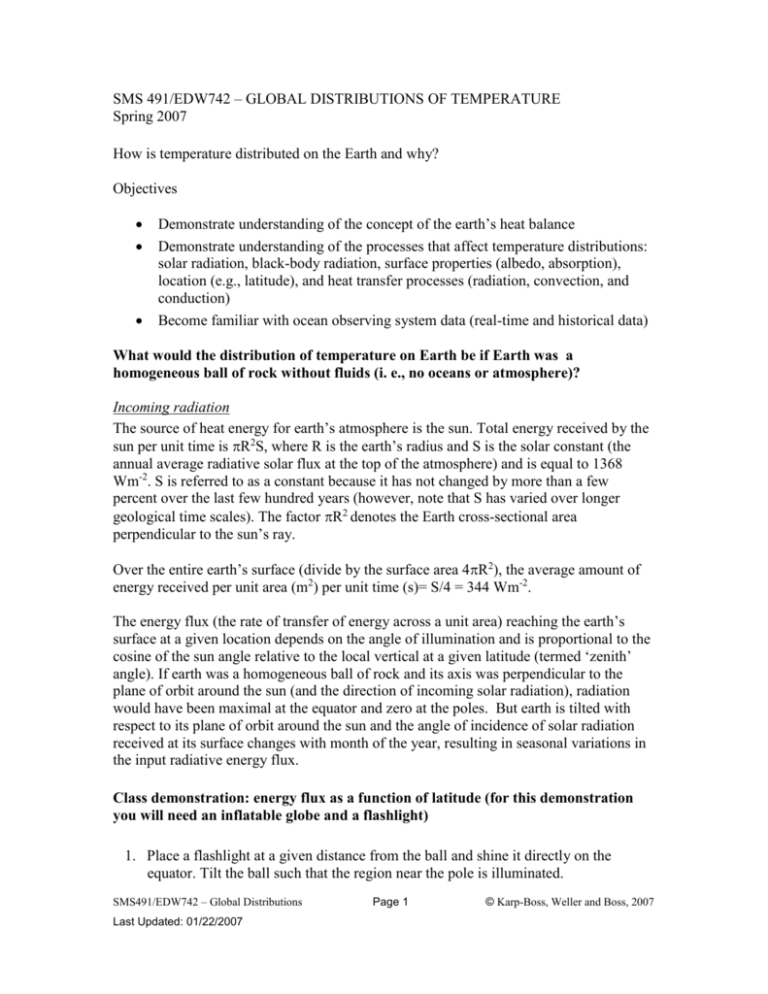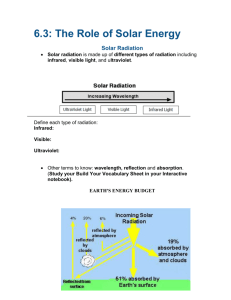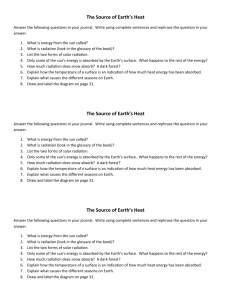Global distributions of temperature:
advertisement

SMS 491/EDW742 – GLOBAL DISTRIBUTIONS OF TEMPERATURE Spring 2007 How is temperature distributed on the Earth and why? Objectives Demonstrate understanding of the concept of the earth’s heat balance Demonstrate understanding of the processes that affect temperature distributions: solar radiation, black-body radiation, surface properties (albedo, absorption), location (e.g., latitude), and heat transfer processes (radiation, convection, and conduction) Become familiar with ocean observing system data (real-time and historical data) What would the distribution of temperature on Earth be if Earth was a homogeneous ball of rock without fluids (i. e., no oceans or atmosphere)? Incoming radiation The source of heat energy for earth’s atmosphere is the sun. Total energy received by the sun per unit time is R2S, where R is the earth’s radius and S is the solar constant (the annual average radiative solar flux at the top of the atmosphere) and is equal to 1368 Wm-2. S is referred to as a constant because it has not changed by more than a few percent over the last few hundred years (however, note that S has varied over longer geological time scales). The factor R2 denotes the Earth cross-sectional area perpendicular to the sun’s ray. Over the entire earth’s surface (divide by the surface area 4R2), the average amount of energy received per unit area (m2) per unit time (s)= S/4 = 344 Wm-2. The energy flux (the rate of transfer of energy across a unit area) reaching the earth’s surface at a given location depends on the angle of illumination and is proportional to the cosine of the sun angle relative to the local vertical at a given latitude (termed ‘zenith’ angle). If earth was a homogeneous ball of rock and its axis was perpendicular to the plane of orbit around the sun (and the direction of incoming solar radiation), radiation would have been maximal at the equator and zero at the poles. But earth is tilted with respect to its plane of orbit around the sun and the angle of incidence of solar radiation received at its surface changes with month of the year, resulting in seasonal variations in the input radiative energy flux. Class demonstration: energy flux as a function of latitude (for this demonstration you will need an inflatable globe and a flashlight) 1. Place a flashlight at a given distance from the ball and shine it directly on the equator. Tilt the ball such that the region near the pole is illuminated. SMS491/EDW742 – Global Distributions Last Updated: 01/22/2007 Page 1 © Karp-Boss, Weller and Boss, 2007 2. Where is the amount of radiative flux per unit area the largest? 3. How are your results related to the changes in temperature between morning and noon, and between seasons? If we assume that all the electromagnetic radiation impinging on the earth is absorbed, then the earth will warm up. However, every body radiates out energy based on its temperature (referred to as a “black body” radiation), eventually the Earth would reach a temperature where the incoming radiation equals its black-body radiation and be in equilibrium. What is the fate of the solar energy impinging on the earth? Activity: Open the tool WorldWatcher (download free from: http://www.worldwatcher.northwestern.edu/softwareWW.htm) Click on the ‘energy balance’ icon. Select “incoming solar energy”, choose average datasets, highlight all the months in the year 1987 and click “ok”. Compare the annual average of the incoming solar radiation and the annual average of the energy absorbed by earth [(to create a map of the absorbed energy, choose absorbed solar energy. Choose average data sets, highlight all the months in 1987 (excluding the ones that indicate clear sky) and click “ok”]. Make sure both maps are on the same scale; compare the values between the two maps. Are there any differences? If so, what may account for the differences? Not all the energy reaching the earth’s surface is absorbed; part of it is reflected back. This is quantified by the ratio of incoming to outgoing short wavelength radiation and is termed the albedo (). The Earth’s albedo has an average value of 0.3 (that is, 30 of the incoming radiation is reflected back). The albedo has no units because it is defined as the fraction of the impinging radiation that is reflected. It follows that the average amount of solar energy absorbed by the Earth, per unit area per unit time is:¼(1-)S= 240Wm-2. Note that we neglect heat emanating from the interior of the earth as it accounts for less than 0.2% of the heat provided by the sun. Activity: Use the WorldWatcher tool to plot the average annual Earth-atmosphere reflectivity. Click on earth-atmosphere reflectivity. Choose average data sets, highlight all the months in 1987 (excluding the ones that indicate clear sky) and click “ok”. Move the cursor and observe how the average reflectivity changes with latitude. Where do you observe lower than average values? Where do you observe higher than average values? Why? SMS491/EDW742 – Global Distributions Last Updated: 01/22/2007 Page 2 © Karp-Boss, Weller and Boss, 2007 What causes variations in albedo on the Earth’s surface? What causes variations between seasons (choose two different months and compare them)? Albedo depends on the color and structure of the surface interacting with the incoming solar radiation and the angle of incoming radiation. Below are some values for the reflectance of different substrates. Snow 80-90% Desert sand 35% Vegetation 10-25% Bare soil or rock 10-20% Asphalt 5-10% Calm water 2% Upward radiation from Earth Absorbed energy by the Earth’s surface will cause the surface to warm up to a temperature for which it radiates as much energy as it absorbs. To compute the emission from the Earth’s surface we use the formula for black body radiation: E = T4 where is the Stephan’s-boltzman constant = 5.7X10-8 W m-2K-4 (0K = -273oC). The temperature at this equilibrium can be calculated by equating incoming and outgoing energy: T4=¼(1-)S= 240Wm-2 SMS491/EDW742 – Global Distributions Last Updated: 01/22/2007 Page 3 © Karp-Boss, Weller and Boss, 2007 Source: http://www.ldeo.columbia.edu/~kushnir/MPAENVP/Climate/lectures/energy/blackbody.gif Activity: Use the WorldWatcher tool to plot the average annual radiation absorbed by earth. Use the formula for black body radiation to calculate the temperature of earth (reached at equilibrium) at the equator and at the South Pole. Compare these values to the map of average annual Earth’s surface temperature. To create a map of surface temperatures, go to earth surface temperature. Select average data sets. Select all the months for the year 1987 and click “ok” (to convert from oC to oF: multiply the Celsius temperature by 1.8 and add 32o to adjust for the offset in the Fahrenheit scale). Why is the earth’s surface much warmer and the differences between the equator and poles smaller, compared to you calculations? Simple calculations of the greenhouse effect: Now let’s add the atmosphere. The atmosphere is transparent to radiation at short wavelength (UV and visible light) but partially absorbs at longer wavelength (infra-red). SMS491/EDW742 – Global Distributions Last Updated: 01/22/2007 Page 4 © Karp-Boss, Weller and Boss, 2007 As downward flux of solar radiation is absorbed by the ground (at short wavelengths), the ground warms up and emits an upward radiation flux at longer wavelength. Similarly to the downward flux, the upward emitted flux (U) equals: U = T4 A fraction (1≥ e ≥0) of this radiated energy is absorbed by the atmosphere and the atmosphere heats up and also emits radiation, but at longer wavelengths, which we denote as 2B (a flux B upwards and a flux B downwards back to the Earth). From the principle of conservation of energy, the upward flux must balance the downward flux of incoming solar radiation (I): I = (1-e)U+B = U-B (radiative equilibrium solution) U = T4 = I/(1-e/2) Since 1≥e≥0 (it is a fraction of a whole), T is higher than if there was no atmosphere (the case where e=0). Source: http://star.arm.ac.uk/climate/images/greenhouse.gif Activity: Use the WorldWatcher tool to plot the mean annual green-house effect (click on greenhouse effect, select average data sets, select all the months for the year 1987 and click “ok”) Is this effect uniform? Why not? SMS491/EDW742 – Global Distributions Last Updated: 01/22/2007 Page 5 © Karp-Boss, Weller and Boss, 2007 Note: the term ‘green house’ effect is actually not accurate to describe the way the atmosphere acts. It turns out that greenhouses are warmer due to suppression of convection (which would act outside the greenhouse) and not because they suppress the radiation in the infra-red (ref here). More accurately, calculations of fluxes involve many wavebands and the absorption of each band is calculated separately. Also, such models must take into account reflection and scattering by clouds (which depends on distributions and albedo of clouds). Heat transfer by atmosphere and oceans (conduction, convection, and horizontal transport) Until now our treatment of the heat budget did not take into account fluid motion. How is the heat balance affected by fluid motion? Heat can be transported by conduction, that is, by molecules passing vibrational energy to each other, and by convection, that is by fluid motion. The contribution of conduction to heat transport is relatively small in the total heat budget and convection is the dominant mechanism of vertical heat fluxes (i.e., in the atmosphere, in the oceans, and between oceans and atmosphere). Convection carries up the atmospheric heat and water vapor that is produced by evaporation. In fact, evaporation is the main mechanism by which oceans lose heat. Water vapor affects heat balance by several ways: 1. When the amount of water vapor reaches a saturation level (function of height), it condenses and forms clouds. Clouds reflect and scatter a significant amount of incoming radiation and thus affect the total amount of energy absorbed by the atmosphere. 2. Water vapor absorbs a fraction of the incoming solar radiation and thus determines the temperature at the lower atmosphere. 3. Cloud formation results in the release of latent heat taken from the ocean at the cloud height; evaporation results in cooling (this process accounts for about 75% of the convective transport) Final equilibrium is therefore dependent on the BALANCE between radiative and convective processes. SMS491/EDW742 – Global Distributions Last Updated: 01/22/2007 Page 6 © Karp-Boss, Weller and Boss, 2007 Source: http://eosweb.larc.nasa.gov/EDDOCS/images/Erb/components2.gif Activity: 1. In a pure radiative- convective equilibrium, the annual average of the space bound energy should equal the annual average of the absorbed energy. Compare the two plots (using WorldWatcher). Is that the case? Why or why not? 2. What would the global distribution of surface isotherms be in the absence of horizontal transport? Go to http://www.osdpd.noaa.gov/PSB/EPS/SST/sst_anal_fields.html. Click on the 50 KM global analysis climatology (for an additional map see http://www.abc.net.au/science/slab/elnino/img/gsst.gif). Are isotherms distributed according to your prediction? Where do they match your prediction and where do they not match? What are some of the processes responsible for the observed deviations? The radiative-convective model we discussed so far considers only vertical gradients in temperature and vertical motion of fluids (air and water). Latitudinal variation in solar energy flux and radiative absorption result in large horizontal gradients in temperature. Lateral fluid motion tends to reduce these gradients (horizontal fluid motions are sometime termed advection to separate them from vertical motions). SMS491/EDW742 – Global Distributions Last Updated: 01/22/2007 Page 7 © Karp-Boss, Weller and Boss, 2007 Balance between average net shortwave (solar radiation) and longwave (radiation emitted from earth) radiation from 90° North to 90° South (source: http://www.physicalgeography.net/fundamentals/7j.html) The overall contributions of oceans and atmosphere to maridional heat transport are similar, but the oceans dominate the horizontal transport at 20oN while atmospheric processes dominate transport at approximately 50oN. SMS491/EDW742 – Global Distributions Last Updated: 01/22/2007 Page 8 © Karp-Boss, Weller and Boss, 2007 Source: http://www.seafriends.org.nz/oceano/ocean48.gif In the absence of meridional transport, ocean surface temperature will gradually decrease with increasing latitude and isotherms would be horizontal lines parallel to the lines of latitude. The pattern of isotherms indeed shows the generalized latitudinal distribution of solar radiation, but variations from horizontal lines, parallel to latitude lines, are also apparent. Several processes contribute to the observed deviations. For example, a band of relatively colder water lies along the equator on the eastern side of the Pacific and Atlantic Oceans. This band is a surface water divergence where deep, cold water is upwelled (convected) to the surface. In mid latitudes, isotherms are inclined toward higher latitudes at the west side of ocean basins. This is a result of warm surface ocean currents (western boundary currents) that transport water and heat pole ward. Due to the Coriolis effect, western boundary currents move into the oceanic interior at the boundary between the subtropical and subpolar gyres. As the current moves east it spreads and cools. So the warmest water at these latitudes tends to be toward the west of the ocean basin. Interactions between land, ocean, and atmosphere also contribute to the deviation from horizontal parallel isotherm lines. Land masses block or stir air and water masses that move along latitudes. Land masses have different thermal properties than oceans because soil and rocks have a lower heat capacity than water. As a result, land warms up and cools down much faster in response to solar radiation, compared to oceans. Reference: Gill, A.E. 1982. Atmosphere-Ocean dynamics. Academic press, Inc. SMS491/EDW742 – Global Distributions Last Updated: 01/22/2007 Page 9 © Karp-Boss, Weller and Boss, 2007









